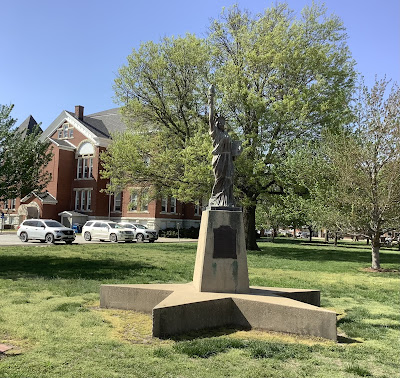
The final three Carnegies of my Kansas perambulations were still functioning as libraries and each had an expansive addition to its backside greatly increasing its space. The first of the set came in Pittsburg, without an “h,” a sizable college town with an enrollment of 7,400 students. The Carnegie did not cater to the collegians and unlike many of the businesses and entities did not have a gorilla out front, Pittsburg State University’s mascot.
This simian infestation made for an odd site. They came in all sizes, but most were in the same crouched posture, and though some were colorfully painted, the vast majority were black.
If such a creature could be tamed to serve as a watch dog, the Carnegie in Girard, fifteen miles to the northwest, could have used one, as it had two different notices protesting delinquent behavior.
Its now closed entrance had a sign admonishing residents from loitering on its steps. It warned that it had security cameras and, “If caught, the police will be called.” It added, “If the rock throwing, fireworks display and trash all over our parking lot doesn’t stop, we will take further action.” The rest room door had a sign forbidding hanging out and prolonging one’s stay there too, with a penalty of being banned from the library for two weeks. Such is life in small town America.
The final Carnegie of my Kansas swing came thirty miles north in Fort Scott. All was quiet there. With it I completed the slate of Carnegies of another state, my sixteenth. I had the pleasure of visiting twenty-five of the sixty-six that were scattered about the state in my thousand plus miles biking from one end of the state to the other, west to east and north to south. Missouri will be the seventeenth, as I have only four more to visit there, the first nineteen miles due east in Nevada.
Shortly after I crossed the border I spotted a license plate on the gravel shoulder of the road. Missouri is distinguishing itself as the license plate state, as I collected four others in my brief foray into the northwest corner of the state ten days ago, twice as many as Kansas provided.
Nevada was another college town, though on a much minor scale, as its college, Cotteye, had a mere 302 students, all women. It is one of twenty-six women colleges remaining in the US, down from 281 in the ‘60s.
Nevada’s Carnegie was now home to an investment company, as was the Carnegie in Burlington, Kansas. It was next to a MacDonalds that had such strong Wi-Fi that it triggered when I pulled out my iPad for a photo. It was significant that Nevada had a Carnegie, as the state of Nevada had only one, in Reno, and it had been razed in 1931, one of the first to be subjected to the wrecker’s ball, not surprisingly in a state not known for having an interest in books.
After three days of blessed tail winds, it was back to a blast to the face as I turned south for over fifty miles, back to forty minute five-mile segments after some that were less than half that in the previous three days. It was grit and bear it and appreciate the greening pastures, mostly filled with cattle. I was out of the wide-open plains, but the patches of trees did little to blunt the wind, almost serving to funnel it. I longed for the roads of France flanked by plane trees, planted by Napoleon to provide shade and wind block for his marching troops.
After thirty-five miles I made a slight detour to Lamar for a Statue of Liberty by its courthouse and was rewarded with the bonus of Harry Truman’s birthplace.
It was a state, rather than national, historic site. I arrived late in the afternoon after the home and the office across the street had closed for the day so could only peer in at the furnishings of the period, 1884, when he was born. The small home had an outhouse to its rear. Truman’s family moved to Independence, a year after his birth, which is where he grew up. He served as a senator from Missouri from 1935 to 1945, before becoming Vice President and president shortly thereafter with the passing of FDR. He was a two-term president, succeeded by Eisenhower.
I battled onward into the wind to Carthage and its distinctive Carnegie, unique with “Andrew Carnegie” chiseled into its facade, contrary to the usual mere “Carnegie.” It had a vast limestone addition to its side adding to its magnificence.











No comments:
Post a Comment